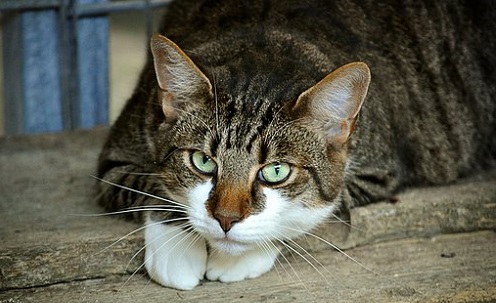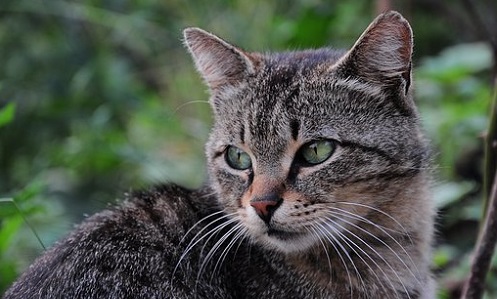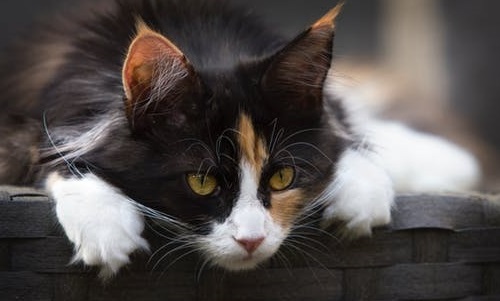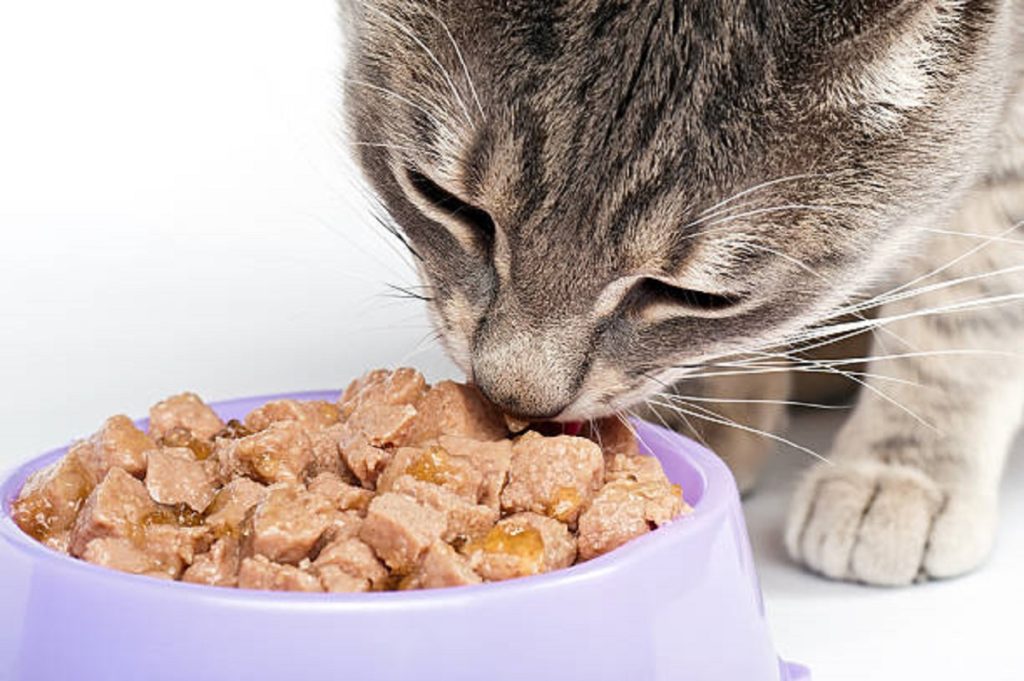It can be difficult to find the right answer to important questions surrounding your cat, including how much and how often to feed him. If you have asked yourself, “How much should I feed my cat?” or “How often should I feed my cat?” you are far from alone. These are common questions to have since the right answer is not a simple one. There is no easy calculation you can do to determine how much food to feed your cat because there is a multitude of different variables that affect how much food he should be consuming to have a healthy and balanced diet.
Some of the factors that will affect how much and how often your cat should eat during the day are his age, breed, weight, metabolic rate, the amount of exercise he gets each day, and his environment. In addition to all of these factors, each food has different ingredients and caloric values, further complicating the process. To help you determine how much you should feed your cat and how often you should feed him, here’s a breakdown that will help you find the right solution for your cat.
Deciding How Much to Feed Your Cat
Because there is no simple method for determining how much food to feed your cat, it can be a challenge as a pet owner to make an informed decision that will help your cat be healthy and get the nutrients he needs. This process is complicated when including the many diverse variables at play, as well as the unique differences between each cat. Finding the right amount of food to feed your kitty will require a certain amount of trial and error before getting it right, but the best place to start is with the feeding guide on the food your cat will be eating.
Often these feeding guides will break down how much food your cat should eat in a twenty-four hour period based on their weight. Keep in mind that these numbers can be inherently unreliable since they are based solely on weight and do not take into consideration the other genetic, environmental, and lifestyle factors at play. Despite this, the feeding guide on your cat’s food can be a helpful starting point in deciding how much to feed your cat. Below is a sample of a feeding guide you may find on cat food:
The amounts of food listed above are the total amount recommended for your cat to consume over a period of twenty-four hours. This means that if you are doing multiple feeding throughout the day, that amount will need to be adjusted accordingly for each feeding. While the feeding guide on your cat’s food is a useful place to start, to make an accurate deduction about how much food your cat should be eating, it is necessary to analyze the other factors that will also affect how much food they need. Some of the most important factors to consider are age, breed, activity level, and the type of food they are eating. Below is an overview of each of these elements and how they can affect the amount of food your cat will need each day.
Age
 Age is one of the most important factors to analyze when deciding how much food your cat needs each day. As a cat ages, their metabolism will change significantly. When a kitten is born, their body will burn through food as it grows into its adult cat form. Once a cat reaches adulthood, the cat’s metabolism will often slow down considerably since they are no longer growing. As a cat ages, their metabolism will often continue to slow down.
Age is one of the most important factors to analyze when deciding how much food your cat needs each day. As a cat ages, their metabolism will change significantly. When a kitten is born, their body will burn through food as it grows into its adult cat form. Once a cat reaches adulthood, the cat’s metabolism will often slow down considerably since they are no longer growing. As a cat ages, their metabolism will often continue to slow down.
Keeping this in mind, kittens and young cats will require more food each day than an adult or elderly cat in order for them to get the nutrients they need. As a cat gets older, it is common for cat owners to have to slowly reduce the amount of food they are feeding their cat each day to make sure that they do not gain excess weight and develop feline obesity. If the amount of food your cat is consuming is equal to what they are burning each day, then they will maintain their weight. In older cats, their metabolism will slow down, burning fewer calories, which is why their food must be adjusted accordingly. It is useful to talk to a licensed veterinarian about your cat to help determine the right amount of food for them to eat each day.
Breed
Another variable to consider when determining how much food to feed your cat is the breed. Different breeds of cats are predisposed to have higher energy levels and thus burn more calories than their more sedentary counterparts. In addition, some breeds of cats may be genetically predisposed to develop certain medical conditions over the course of their lifetime, which should be taken into consideration when finding the right amount of food to feed each day.
Activity Level
One of the most significant factors to analyze when calculating how much food they will need is the amount of exercise your cat gets each day. As mentioned previously, the number of calories your cat consumes needs to be equal to the number of calories they are burning each day for them to maintain their weight. If your cat lives an active life where he receives regular exercise, then he will require more food each day than a cat that sleeps and engages in a minimal amount of activity. If a cat is doing a minimal amount of activity each day, their food will likely need to be decreased accordingly to avoid gaining excess weight.
Finding the right amount of food to feed your cat based on the amount of exercise he does will take a measure of trial and error. To monitor your cat’s weight, adjust your cat’s food to the amount you think he needs based on his age, breed, activity level, and weight. From there, weigh your cat each week and see if he is maintaining his weight. If he begins to lose weight, then he will need the amount of food he is receiving to be increased. If he begins to gain weight, then you will need to decrease the amount of food he is receiving to prevent excess weight gain. Once you have found the right amount of food needed to maintain his weight, you will need to intermittently check to make sure your cat’s weight is holding steady as he ages and other lifestyle factors shift.

Type of Food
Another variable to consider is the specific type of food you are feeding your cat. Each food is made using different ingredients, which shift its nutritional profile. It is important that your cat is receiving the right balance of carbohydrates, proteins, and fats he needs each day for him to maintain optimum health. Whether you are feeding your cat dry or wet food, it is important to look at the ingredient list and make sure you are feeding your cat high-quality, nutritionally dense food that will support healthy body functions.
Deciding How Often to Feed Your Cat
In addition to deciding how much you want to feed your cat, you must also decide how often you will feed your cat. Many cat owners will feed their cat twice each day, splitting their daily amount of food into halves. However, there are many different approaches you can take to feeding your cat. Below are two of the most common methods for feeding your cat and choosing the right method will be dependent on your lifestyle and your cat.
Letting Your Cat Decide
One of the most common feeding schedules for a cat is at any time they want. This is accomplished by leaving food out all day and all night and allowing your cat to dictate when and how much they eat. This feeding schedule is based on the idea that a cat will only eat the amount they need and will take the initiative to feed themself whenever they get hungry. This eliminates the need for scheduled feedings and instead places the decision on the cat. This type of feeding schedule is a good fit for a cat that is at a healthy weight and has a high level of activity each day.
However, this feeding schedule can be problematic for some cats. Some cats may eat more food than they need if they constantly have access to an unlimited supply of food, which will lead to weight gain and subsequent health problems. Another potential issue is that for this feeding schedule to work, you must leave food out for your cat all the time, which can attract insects, rodents, or raccoons.
Scheduled, Portion Controlled Feedings
 Another approach to feeding your cat is to feed your cat at set times throughout the day with a set amount of food. The number of feedings can vary based on your individual schedule anywhere from one to three feedings per day. Two is the most commonly selected feeding schedule, with one feeding in the morning and one at night. Tailor your cat’s feeding schedule to meet your lifestyle needs. This method of feeding allows your cat to develop a set schedule that it can rely on receiving food at, and it ensures that your cat will not gain or lose excess weight since you can control how much food they are receiving. The downside to this feeding schedule is that it places more responsibility on the owner to meet the feeding schedule each day and determine the right amount of food for their cat.
Another approach to feeding your cat is to feed your cat at set times throughout the day with a set amount of food. The number of feedings can vary based on your individual schedule anywhere from one to three feedings per day. Two is the most commonly selected feeding schedule, with one feeding in the morning and one at night. Tailor your cat’s feeding schedule to meet your lifestyle needs. This method of feeding allows your cat to develop a set schedule that it can rely on receiving food at, and it ensures that your cat will not gain or lose excess weight since you can control how much food they are receiving. The downside to this feeding schedule is that it places more responsibility on the owner to meet the feeding schedule each day and determine the right amount of food for their cat.
Common Cat Feeding Mistakes
Many cat owners unknowingly make mistakes when determining how much and how often to feed their cat. It can be a daunting task to find the right balance and many owners will encounter an error before they succeed in finding the right amount of food and feeding schedule. Below is a handful of the most common cat feeding mistakes cat owners make.
- Feeding Too Much Food: It can be tempting to err on the side of caution and give your cat a bit more food than you think he really needs. This makes you feel better as a pet owner because you are confident that you are not feeding them too little. However, feeding your cat too much food can also be an issue. If your cat is constantly eating in excess of what his body needs, he will begin to gain weight, which can lead to a number of health problems.
- Not Offering Enough Water: Water is vital for all animals and human beings to sustain a healthy and balanced life. Water comprises roughly sixty to seventy percent of a cat’s body, making it vital to their bodily processes. One mistake many cat owners make is not leaving enough fresh water available for their cat throughout the day. If your cat is not drinking enough water, he will become dehydrated, which can be dangerous.
- Creating Nutrient Deficiencies: One issue that some pet owners have is accidentally creating nutrient deficiencies by not feeding their cat a well-balanced diet. Your cat needs the right ratio of foods to meet his nutrient requirements and to support healthy bodily processes. Some pet owners may run into issues by attempting to make their own pet food for their cat without analyzing the ratio of different elements that make up the food to ensure that they meet the nutritional requirements the cat needs.
By following this helpful guide, you should have no issues when it comes time to feeding your cat. Just remember, if you have any doubts or questions, it is always recommended to talk to a veterinarian for professional assistance.





